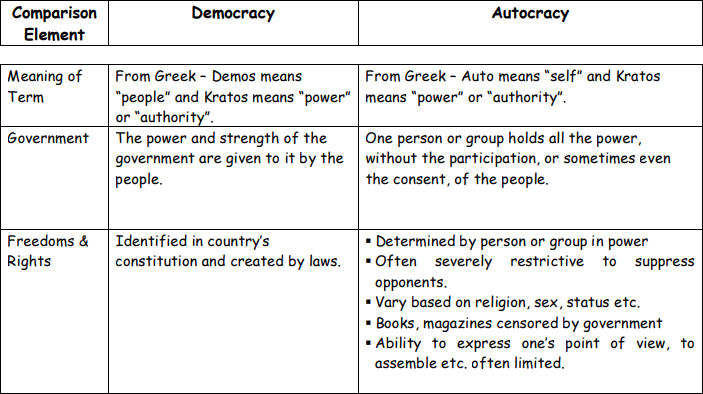Governance
Democracy Report 2022
- 08 Mar 2022
- 7 min read
For Prelims: Democracy Report 2022, India's Rank.
For Mains: Threat to Democracy and related issues, Findings of the Democracy Report 2022.
Why in News?
According to the latest report from the V-Dem Institute at Sweden’s University of Gothenburg, the level of democracy enjoyed by the average global citizen in 2021 is down to 1989 levels, with the democratic gains of the post-Cold War period eroding rapidly in the last few years.
- The Report is titled ‘Democracy Report 2022: Autocratisation Changing Nature?’.
- Varieties of Democracy (V-Dem) produces the largest global dataset on democracy with over 30 million data points for 202 countries from 1789 to 2021.
- Earlier, the Global State of Democracy Report, 2021 was released by the International Institute for Democracy and Electoral Assistance (International-IDEA).
What Parameters were used to Assess the Status of a Democracy?
- The report classifies countries into four regime types based on their score in the Liberal Democratic Index (LDI):
- Liberal Democracy, Electoral Democracy, Electoral Autocracy, and Closed Autocracy.
- The LDI captures both liberal (individual and minority rights) and electoral aspects (free and fair elections) of a democracy based on 71 indicators that make up the Liberal Component Index (LCI) and the Electoral Democracy Index (EDI).
- The LCI measures aspects such as protection of individual liberties and legislative constraints on the executive, while the EDI considers indicators that guarantee free and fair elections such as freedom of expression and freedom of association.
- In addition, the LDI also uses an Egalitarian Component Index (to what extent different social groups are equal), Participatory Component Index (health of citizen groups, civil society organisations), and Deliberative Component Index (whether political decisions are taken through public reasoning focused on common good or through emotional appeals, solidarity attachments, coercion).
What are the Main Findings of the Report?
- Top Performance:
- Sweden topped the LDI index, other Scandinavian countries such as Denmark and Norway, along with Costa Rica and New Zealand make up the top five in liberal democracy rankings.
- India’s Performance:
- India is part of a broader global trend of an anti-plural political party driving a country’s autocratisation.
- It was ranked 93rd in the LDI, India figures in the “bottom 50%” of countries.
- It has slipped further down in the Electoral Democracy Index, to 100, and even lower in the Deliberative Component Index, at 102.
- In South Asia, India is ranked below Sri Lanka (88), Nepal (71), and Bhutan (65) and above Pakistan (117) in the LDI.
- Spreading Autocratisation:
- Autocratisation is spreading rapidly, with a record of 33 countries autocratising.
- Signaling a sharp break from an average of 1.2 coups per year, 2021 saw a record 6 coups, resulting in 4 new autocracies: Chad, Guinea, Mali and Myanmar.
- While the number of liberal democracies stood at 42 in 2012, their number has shrunk to their lowest level in over 25 years, with just 34 countries and 13% of the world population living in liberal democracies.
- Closed autocracies, or dictatorships, rose from 25 to 30 between 2020 and 2021.
- Electoral Autocracy Most Common Regime Type:
- The world today has 89 democracies and 90 autocracies, electoral autocracy remains the most common regime type, accounting for 60 countries and 44% of the world population or 3.4 billion people.
- Electoral democracies were the second most common regime, accounting for 55 countries and 16% of the world population.
PYQ
Which one of the following factors constitutes the best safeguard of liberty in a liberal democracy?
(a) A committed judiciary
(b) Centralization of powers
(c) Elected government
(d) Separation of powers
Ans: (d)
What does the report say about the Changing Nature of Autocratisation?
- Biggest Drivers of Autocratisation:
- One of the biggest drivers of autocratisation is “toxic polarisation”.
- Polarisation has been defined as a phenomenon that erodes respect of counter-arguments and associated aspects of the deliberative component of democracy.
- It is a dominant trend in 40 countries, as opposed to 5 countries that showed rising polarisation in 2011.
- Toxic levels of polarisation contribute to electoral victories of anti-pluralist leaders and the empowerment of their autocratic agendas.
- Noting that “polarisation and autocratisation are mutually reinforcing”, the report states that “measures of polarisation of society, political polarisation, and political parties’ use of hate speech tend to systematically rise together to extreme levels.”
- One of the biggest drivers of autocratisation is “toxic polarisation”.
- Tools used to Sharpen Polarisation:
- “Misinformation” has been identified as a key tool deployed by autocratising governments to sharpen polarisation and shape domestic and international opinion.
- Repression of civil society and censorship of media were other favoured tools of autocratising regimes.
- While freedom of expression declined in a record 35 countries in 2021, with only 10 showing improvement, repression of Civil Society Organisations (CSOs) worsened in 44 countries over the past ten years, “putting it at the very top of the indicators affected by autocratisation”.
- Also, in 37 countries, direct government control over CSOs’ existence moved in an authoritarian direction — “evidence of the far-ranging weakening of civil society around the world.”
- Decisive autonomy for the Electoral Management Body (EMB) deteriorated in 25 countries.
PYQ
Democracy’s superior virtue lies in the fact that it calls into activity (2017)
(a) the intelligence and character of ordinary men
and women.
(b) the methods for strengthening executive leadership.
(c) a superior individual with dynamism and vision.
(d) a band of dedicated party workers.
Ans: (a)







